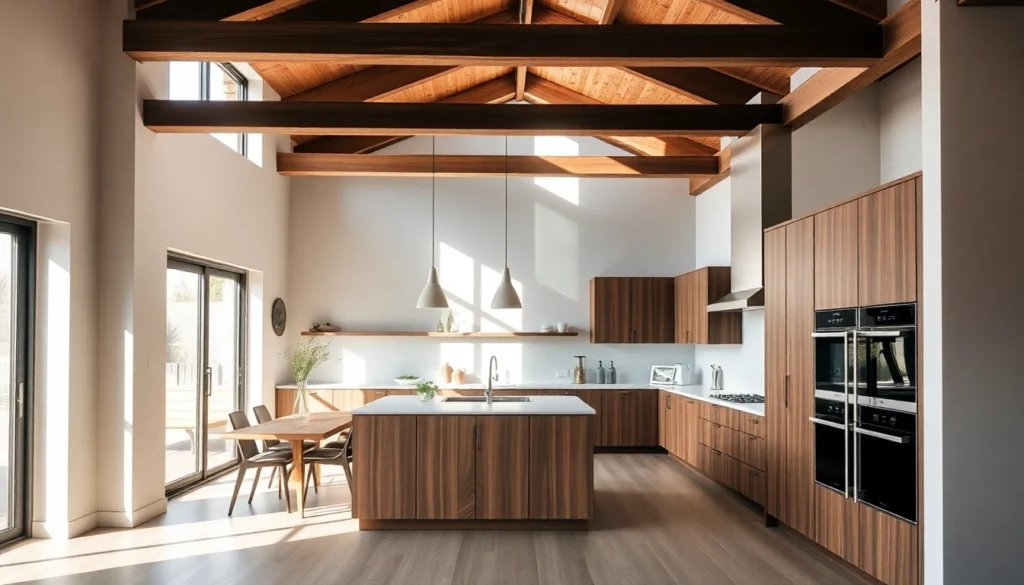Understanding Remodeling: Definition, Scope, and Benefits
Remodeling is a transformative process that involves making significant changes to a property’s physical structure, layout, or aesthetic features. Unlike simple cosmetic updates, remodeling encompasses extensive modifications that can enhance functionality, improve safety, increase home value, and reflect personal style. Whether updating a kitchen, expanding a foundation, or redesigning an entire house, remodeling allows homeowners to tailor spaces to their evolving needs and preferences.
Remodeling has become an essential aspect of homeownership, especially in a competitive real estate market where modern, customized spaces garner premium value. As such, understanding what remodeling entails, how it differs from similar concepts, and the myriad benefits it provides is critical for anyone considering a major home upgrade.
What Does Remodeling Mean in Home Improvement?
At its core, remodeling refers to the act of altering the original structure or appearance of a space to improve its function, style, or both. According to the Collins Dictionary, remodeling (or US remodeling) is the act of “changing or altering the structure, style, or form of something.” In home improvement, this could mean replacing outdated layouts, removing walls to create open floor plans, upgrading electrical systems, or adding new rooms.
Remodeling projects go beyond superficial fixes—they involve substantive changes that might include structural modifications such as knocking down or building walls, reconfiguring floor plans, or replacing major building components like roofing, windows, and HVAC systems. These changes are typically driven by evolving lifestyle needs, technological advancements, or a desire to modernize old properties.
The goal of remodeling is to create a more functional, efficient, and appealing living environment, all while increasing the long-term value of your property. Modern remodeling strategies often emphasize energy efficiency, sustainability, and smart home integrations, making homes more adaptable to future needs.
Key Differences Between Remodeling and Renovating
While often used interchangeably, remodeling and renovating are distinct concepts with different scopes and objectives. Understanding these differences helps homeowners plan more effectively and set realistic expectations.
- Renovating: Focuses on restoring or updating a space mainly for aesthetic improvements. Renovations typically involve cosmetic changes such as painting, replacing fixtures, refinishing floors, or updating appliances. It enhances a home’s appearance without altering its structural elements. For example, repainting walls, installing new countertops, or updating light fixtures fall under renovation.
- Remodeling: Entails comprehensive structural changes aimed at transforming the home’s layout, functionality, or both. Remodeling can involve removing or adding walls, changing floor plans, relocating kitchens or bathrooms, or upgrading major systems. It often requires permits, engineering, and skilled craftsmanship due to its extensive nature.
Both processes can significantly increase property value and livability, but remodeling generally offers a higher return on investment because of its transformative impact. For instance, a kitchen remodel that reconfigures the space might substantially enhance the home’s appeal and usability, whereas repainting a room is primarily aesthetic.
Ultimately, choosing between renovation and remodeling depends on the homeowner’s goals, budget, and the existing condition of the property. Sometimes, a remodeling project might start with cosmetic upgrades but evolve into a full transformation requiring substantial structural work.
How Remodeling Adds Value to Your Home
Strategic remodeling can significantly boost your property’s market value. According to various home investment studies, some projects provide higher returns than others, especially in high-demand markets like Rochester, NY. Key areas that maximize value include kitchens, bathrooms, basements, and curb appeal improvements.
- Kitchens: As the heart of the home, modern kitchens with updated appliances, cabinetry, and layouts attract buyers and increase resale value. An open-concept kitchen, in particular, is highly desirable.
- Bathrooms: Upgrading bathrooms with new fixtures, tiles, and fixtures can transform cramped or outdated spaces into luxurious retreats.
- Basements and Additions: Finishing basements or adding extra rooms can expand usable living space, making the property more attractive and functional.
- Curb Appeal: Exterior improvements like new siding, roofing, landscaping, and entryway upgrades create great first impressions and can significantly influence buyer decisions.
Beyond aesthetic enhancement, remodeling improves energy efficiency—installing new windows, insulation, or smart home technology can reduce utility costs and appeal to eco-conscious buyers.
Securing a professional remodeling company ensures that these upgrades are executed with quality craftsmanship, code compliance, and adherence to local regulations, ultimately safeguarding and elevating your investment.
Planning Your Remodeling Project: From Concept to Execution
Evaluating Your Needs and Setting a Budget
Successful remodeling begins with a thorough assessment of your needs. Consider how your current space functions—are there layout limitations, storage issues, or outdated features? Identifying priorities helps you determine the scope of work and assists in establishing a realistic budget.
Experts recommend setting a contingency fund—typically 10-20% of your total budget—to address unforeseen issues such as hidden damages, code upgrades, or material price fluctuations. For example, older homes may have outdated wiring or plumbing that requires costly repairs.
When drafting your budget, consider the desired level of quality, scope of upgrades, and long-term value. A professional remodeling contractor can help you develop a detailed estimate aligned with your financial plan.
Choosing the Right Remodeling Contractor
Selecting a reputable and experienced contractor is crucial to the success of your project. Look for licensed, insured, and highly rated professionals with a track record of delivering quality work on time and within budget.
Start by researching local companies—review online reviews, request references, and examine their portfolio of completed projects. Asking for detailed proposals and written contracts ensures clarity regarding scope, materials, timelines, and payment schedules.
To narrow your choices, consider specialized expertise; for example, some contractors focus on kitchen or bathroom remodels, while others manage entire home renovations. Ensuring good communication and a transparent process fosters trust and smooth project management.
For instance, companies like Bryce & Doyle](https://www.bryceanddoyle.com/), known for over 40 years in Rochester, NY, exemplify reliable remodeling firms capable of handling comprehensive projects with professionalism.
Designing Your Dream Space with Professional Help
Collaborating with design professionals helps translate your vision into tangible plans that maximize space and function. From initial sketches to 3D renderings, a designer can optimize layout, lighting, materials, and finishes.
Modern design-build firms often offer integrated services—ranging from conceptual design to project management—ensuring seamless execution. They consider current trends, energy efficiency, and the latest smart home technology, aligning your project with future-proof standards.
During this phase, it’s essential to communicate your priorities clearly—whether emphasizing aesthetics, sustainability, or budget constraints. A collaborative approach results in a personalized environment that reflects your lifestyle and preferences.
Best Practices for a Successful Remodeling Experience
Effective Communication and Clear Contracts
Transparency and communication are the foundation of a successful remodeling project. Establish clear expectations from the start—discuss scope, timelines, budget, and materials. Detailed contracts should specify work phases, payment terms, warranties, and dispute resolution procedures.
Regular updates, site visits, and open channels for questions help address issues promptly, avoiding misunderstandings or delays. Keeping all stakeholders informed fosters trust and accountability.
Selecting Quality Materials and Skilled Craftsmanship
Material selection impacts durability, appearance, and long-term maintenance costs. Working with suppliers and designers ensures access to high-quality, sustainable options that fit your aesthetic and budget.
Skilled craftsmanship ensures that installations meet industry standards and building codes. Certified carpenters, electricians, and plumbers bring expertise to complex tasks—merging functionality with fine detail.
For example, opting for energy-efficient windows and eco-friendly finishes not only reduces utility bills but also appeals to environmentally conscious buyers.
Managing Timeline and Budget Expectations
Realistic scheduling and financial planning are vital. External factors like supply chain disruptions can cause delays, so build flexibility into your timeline. Regular monitoring and proactive decision-making reduce unexpected costs.
Using project management tools or working closely with your contractor helps you stay within budget—prioritizing essential upgrades over optional extras if needed.
Ultimately, a well-managed project results in a smooth process, minimizing stress and ensuring your vision is realized efficiently.
Innovative Trends in Home Remodeling
Sustainable and Eco-Friendly Remodeling Options
Sustainability is increasingly influential in home remodeling. Options include installing solar panels, utilizing recycled materials, and improving insulation to reduce energy consumption. Green building certifications, such as LEED, guide eco-conscious upgrades that lower utility bills and environmental impact.
For example, choosing locally sourced, sustainable wood or low-VOC paints enhances indoor air quality and supports responsible sourcing.
Incorporating energy-efficient appliances and smart systems further reduces carbon footprints while delivering modern convenience.
Smart Home Integration and Technology
The integration of technology into remodeling projects transforms homes into smart, connected environments. Features such as automated lighting, thermostats, security systems, and voice-controlled devices improve convenience, security, and energy management.
During remodels, wiring for future integrations and installing compatible systems ensures ease of upgrade and adaptability.
Emphasizing technology not only benefits homeowners but also increases market appeal for future resale.
Popular Design Styles and Modern Aesthetics
Contemporary style favors clean lines, minimalism, and neutral color palettes, often paired with eco-friendly materials and smart technology. Rustic, Industrial, and Mid-century Modern are also popular, each characterized by distinct features ranging from exposed structural elements to sleek finishes.
Trends emphasize flexible, multi-functional spaces, open floor plans, and mixed materials—combining wood, metal, glass, and textured surfaces to create visually appealing environments.
Measuring the Impact: Ensuring Long-Term Satisfaction
Post-Project Inspection and Adjustments
Once the project nears completion, a thorough walkthrough with your contractor ensures all work meets agreed standards. Promptly address any deficiencies or adjustments before finalizing payments. Detailed punch lists help clarify remaining tasks and prevent future issues.
Additionally, obtaining warranties on workmanship and materials safeguards your investment, providing peace of mind.
Maintaining Your Remodel for Lasting Results
Proper maintenance extends the life of your remodel. Regular cleaning, inspections for leaks or damages, and prompt repairs preserve functionality and appearance. For example, sealing grout lines, checking for mold, or replacing worn fixtures enhances durability.
Keeping up with technological systems and updating finishes as needed ensures your home remains modern and efficient.
Tracking Return on Investment and Resale Value
Thorough documentation of renovations—including before and after photos, receipts, and warranties—helps demonstrate value to potential buyers. Home appraisals often favor updated or remodeled spaces, leading to higher resale prices.
Working with real estate professionals can help strategize renovations that maximize ROI based on local market trends.





